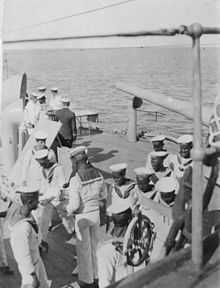HMS Venus (1895)
For other ships of the same name, see HMS Venus.
_IWM_Q_021897.jpg) Venus at anchor during World War I | |
| Career (United Kingdom) | |
|---|---|
| Name: | HMS Venus |
| Namesake: | Venus |
| Builder: | Fairfield Shipbuilding & Engineering, Govan |
| Laid down: | 28 June 1894 |
| Launched: | 5 September 1895 |
| Completed: | 9 November 1897 |
| Fate: | Sold for scrap, 22 September 1921 |
| General characteristics | |
| Class and type: | Eclipse-class protected cruiser |
| Displacement: | 5,600 long tons (5,690 t) |
| Length: | 350 ft (106.7 m) |
| Beam: | 53 ft 6 in (16.3 m) |
| Draught: | 20 ft 6 in (6.25 m) |
| Installed power: | 9,600 ihp (7,200 kW) 8 cylindrical boilers |
| Propulsion: | 2 shafts, 2 Inverted triple-expansion steam engines |
| Speed: | 18.5 knots (34.3 km/h; 21.3 mph) |
| Complement: | 450 |
| Armament: | As built: 5 × QF 6-inch (152 mm) guns 6 × QF 4.7-inch (120 mm) guns 6 × 3-pounder QF guns 3 × 18-inch torpedo tubes After 1905: 11 × six-inch QF guns 9 × 12-pounder QF guns 7 × 3-pounder QF guns 3 × 18-inch torpedo tubes |
| Armour: | Gun shields: 3 in (76 mm) Engine hatch: 6 in (152 mm) Decks: 1.5–3 in (38–76 mm) Conning tower: 6 in (152 mm) |
HMS Venus was an Eclipse-class protected cruiser built for the Royal Navy in the mid-1890s.
She was commanded by Sir Archibald Berkeley Milne and served at the Mediterranean Station until March 1901, when she paid off at Chatham Dockyard.[1]
In 1908 Venus attended the Quebec Tercentenary in Canada.[2]

Somali Crewmen on HMS Venus, 1916
She joined the 3rd Fleet at Pembroke in 1913 and went to Portsmouth in 1914. Joined the 11th Cruiser Squadron in Ireland in August 1914; captured two German merchantmen in October and lost her foremast in a gale in November 1914. To Egypt 1916; Singapore March 1917; flagship East Indies 1919 until she returned home in May 1919 to pay off. [3]
References
- ↑ "Naval & Military intelligence" The Times (London). Friday, 8 March 1901. (36397), p. 10.
- ↑ The Quebec Tercentenary commemorative history
- ↑ Conway's All the World's Fighting Ships 1906-21
Bibliography
- Chesneau, Roger; Kolesnik, Eugene M., eds. (1979). Conway's All the World's Fighting Ships 1860–1905. Greenwich, UK: Conway Maritime Press. ISBN 0-8317-0302-4.
- Colledge, J. J.; Warlow, Ben (2006) [1969]. Ships of the Royal Navy: The Complete Record of all Fighting Ships of the Royal Navy (Rev. ed.). London: Chatham Publishing. ISBN 978-1-86176-281-8. OCLC 67375475.
- Gardiner, Robert; Gray, Randal, eds. (1984). Conway's All the World's Fighting Ships: 1906–1921. Annapolis, Maryland: Naval Institute Press. ISBN 0-85177-245-5.
- McBride, Keith (2012). "The Cruiser Family Talbot". In John Jordan. Warship 2012. London: Conway. pp. 136–41. ISBN 978-1-84486-156-9.
External links
| Wikimedia Commons has media related to HMS Venus (ship, 1895). |